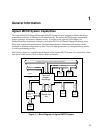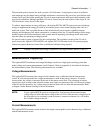
General Information - 1
17
The Agilent MCCD measures the dc cell resistance by first disconnecting the charge/discharge circuits
from all cells. A pulse generator in the Agilent MCCD mainframe is connected sequentially to each cell.
The pulse generator passes a short-duration pulsed current through each cell while the measurement
system digitizes the cell voltage and current using a high accuracy, high-speed A/D converter. Using
proprietary algorithms to calculate the change in voltage relative to the change in pulsed current, a dc (or
pulse) resistance measurement of the cell can be made. Since this measurement happens sequentially for
each channel, the other channels stay at rest during this test.
Probe Resistance
Probe resistance measurements can also be performed. The Agilent MCCD uses the remote sense to
measure the resistance of both the power and sense probes. Probe resistance measurements can be made
on command when a sequence is not running.
The measured probe resistance is the total resistance in the signal path, which includes wiring resistance,
probe resistance, and the resistance of any connectors in the signal path. For the sense probe
measurement, the resistance measurement includes the internal scanner resistance, which is typically
1000 ohms. The power and sense probe measurements return the actual measured value in ohms.
In addition to the on-command probe resistance measurements, the probes are continuously checked
while the sequence is running. See chapter 5 under “Probe Check” for more information about probe
check verification.
Data Logging
During a charge/discharge sequence, the Agilent MCCD is constantly making voltage, current, and
capacity measurements. Instead of logging each and every measurement into a data buffer, the data
logging can be controlled so that only critical measurements are logged to the data buffer. This is called
event-based data logging, which means that whenever an important event occurs, a data log record will
be written into the data buffer. Buffer memory is used most efficiently when only critical measurements
are stored.
The following events can be used to trigger critical measurements:
Change in voltage
(∆V)
If the trigger is ∆V, a data log record will be written to the buffer when a user-
specified voltage change is exceeded. If ∆V is set to 100 mV, then each time the
voltage reading changes by more than 100 mV, a record is written to the buffer.
Change in current
(∆I)
If the trigger is ∆I, a data log record will be written to the buffer when a user-
specified current change is exceeded. If ∆I is set to 100 mA, then each time the
current reading changes by more than 100 mA a record is written to the buffer.
Change in time
(∆t)
If the trigger is ∆t, a data log record will be written to the buffer when a user-
specified time interval is exceeded. If ∆t is set to 1 second, then every second a
record is written to the buffer. ∆t is effectively a clock-driven data log.
The acceptable range of values for ∆V, ∆I and ∆t are 0 to infinity. Setting the value to 0 or near 0 will
cause all readings to be logged in the buffer, because every reading will exceed the ∆V, ∆I or ∆t value of
zero. This will fill up the measurement log very quickly. Setting the value to a high number or to infinity
will cause no readings to be logged in the buffer because no reading will exceed the ∆V, ∆I or ∆t value.


















